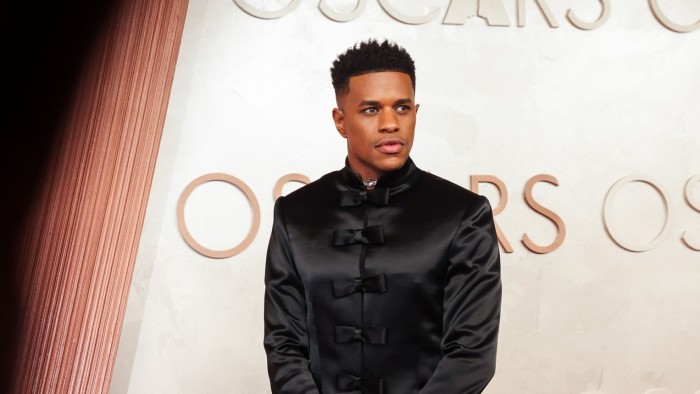Unlock the Editor’s Digest for free
Roula Khalaf, Editor of the FT, selects her favourite stories in this weekly newsletter.
Something is stirring in the world of men’s blazers. For the past decade or two, peak and notch lapels have dominated. But now the stand collar is emerging — offering an elegant alternative to the traditional tailored jacket.
At this year’s Oscars ceremony, actor Jeremy Pope stood out on the red carpet in a stand-collar satin suit from Balmain. And on the spring/summer catwalks, Alessandro Michele’s buzzy debut collection for Valentino featured a series of stand-collar jackets, from a characteristically jazzy paisley version piped in velvet to a tweed shirt jacket. Giorgio Armani, the crown prince of mandarin collars, showed a series of silky cupro suits finished in the cut, while Dries Van Noten offered his in wool. The jackets looked easy and rakish, tailored with just as much rigour as traditional blazers but somehow more modern — sharply cut outer layers sent from the future to reinvigorate our wardrobes.
“We’ve injected more stand-collar jackets into our offering this season, as part of a wider focus on more casual takes on traditional sports jackets or blazers,” says Reece Crisp, buying and creative director of London-based concept store LN-CC.
Depending on where you are in the world, stand-collar jackets go by different names. On the Indian subcontinent, they’re best known as Nehru jackets after the former prime minister, who wore stand collars almost exclusively. In east Asia, it’s all about the mandarin collar — or Zhongshan Zhuang as it’s known in China. In Spain, traditional stand-collar hunting jackets are known as Tebas.
In South Tyrol, the small Alpine region straddling the border of Italy and Austria, stand-collar jackets are worn in both formal and more casual settings. So it’s perhaps little wonder that Tyrolean native Andreas Steiner, who founded the label Rier in 2019, has become one of the leaders of the jacket’s revival with his minimalist take. The “Walker”, a classic cardigan style which is available in both the traditional seat-covering length and a more contemporary cropped version, is crafted from a felted wool known in South Tyrol as “walken”. This technique, which involves repeatedly soaking and compressing the wool to create a dense, weather-resistant fabric, is closely connected to the area’s agricultural history, while the restrained cuts of the jackets are shaped by Steiner’s years working at Prada.
“These jackets were traditionally worn by farmers,” says Steiner. “The felting method developed because they had sheep, and wool was the only raw material available. Living in the mountains, where it was very cold, they needed durable, insulating fabrics.”
The challenge when wearing stand-collar jackets today is to avoid their more unfortunate stereotypes. Sport carelessly and you’ll end up looking like a certain breed of very posh man — picture a septuagenarian antiques dealer wearing one to the Cheltenham Festival — or a premiership footballer at a ’90s wedding in Chelmsford.
The key to making it work is to keep things casual — with a T-shirt and jeans when it’s warm, or over a crew- or roll-neck jumper if it’s crisp. Flat-soled slippers will work well, enhancing the style’s louche aesthetic.
“If I were to wear a stand-collar jacket at a formal function, I would consider myself in costume, or trespassing,” says menswear stylist William Gilchrist, who happens to be wearing a navy blue stand-collar cardigan jacket when we speak. “I see such jackets as softer, more casual pieces. I have no interest in looking like a Beatles tribute band member. So keep it soft and choose a good linen tee beneath.”
For Steiner, the appeal of stand-collar jackets is as much about practicality as style. “I started making these jackets because they’re part of my culture but also because they feel very modern,” he says. “I like the attitude of the piece because it’s really like a cardigan. It’s kind of chic, it’s not over-constructed. You can just throw it on, or take it on a plane or leave it in your car or at the office. It’s just very simple. It doesn’t wrinkle. I like that aspect of it.”
You needn’t spend a fortune to join the stand-collar tribe. Sirplus, a British brand that began by creating garments from surplus fabrics, excels in cropped stand-collar jackets that feel easy to wear and come in at under £500. Jermyn Street tailoring house Favourbrook offers an elegant line in velvet stand-collar jackets, with styles ranging from casual to formal. And high-street stalwart Massimo Dutti has released an excellent double-faced wool stand-collar jacket in charcoal for spring (which, at £199 is so affordable I’ve bought it myself).
And if all else fails, vintage stand-collar jackets are plentiful, given their last major moment was around three decades ago. Word to the wise, the charity shops of Cheltenham and Chelmsford are probably good places to start your search.
Follow us on Instagram and sign up for Fashion Matters, your weekly newsletter about the fashion industry
Read the full article here

